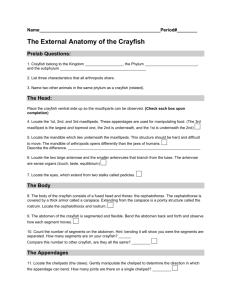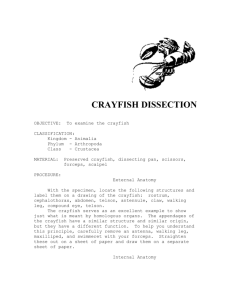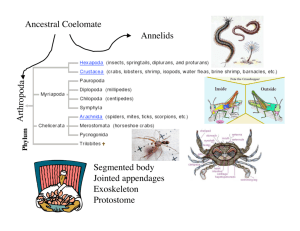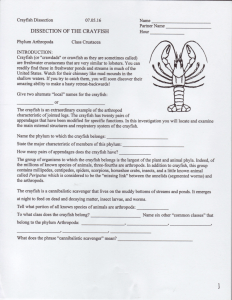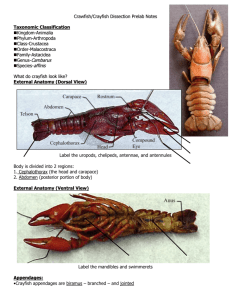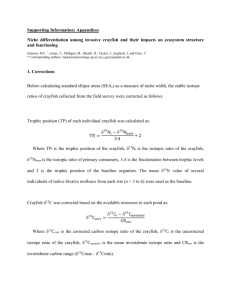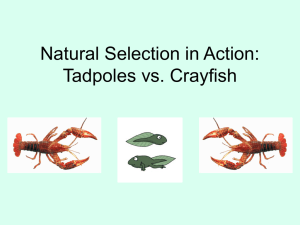Crayfish Dissection Lab: Anatomy Guide
advertisement
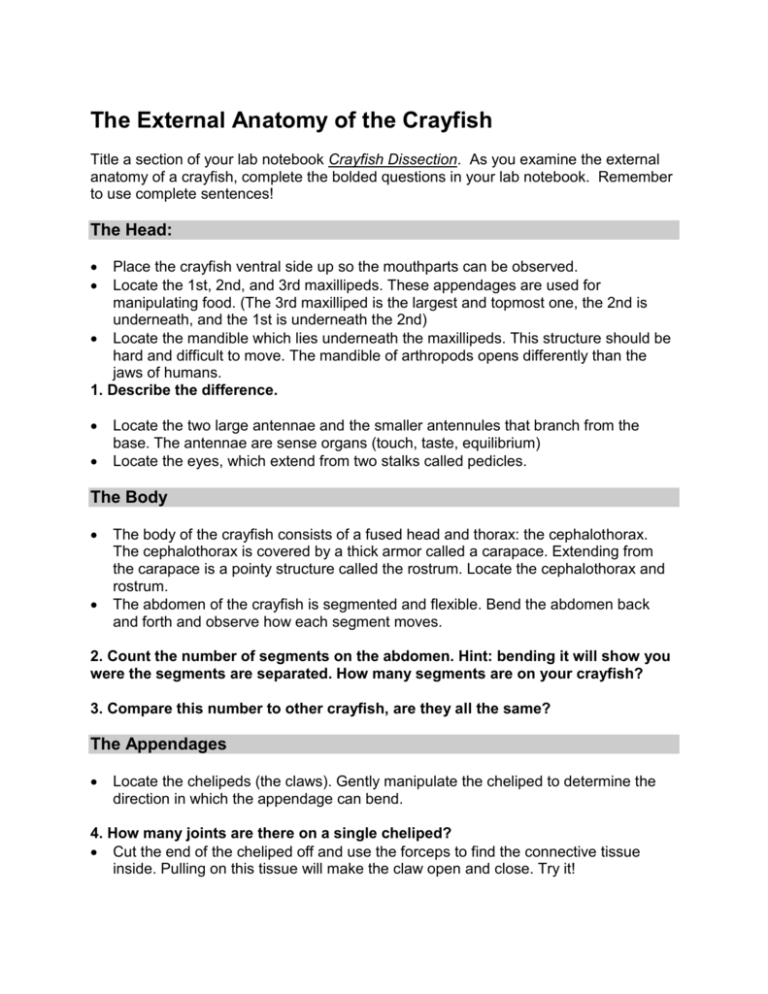
The External Anatomy of the Crayfish Title a section of your lab notebook Crayfish Dissection. As you examine the external anatomy of a crayfish, complete the bolded questions in your lab notebook. Remember to use complete sentences! The Head: Place the crayfish ventral side up so the mouthparts can be observed. Locate the 1st, 2nd, and 3rd maxillipeds. These appendages are used for manipulating food. (The 3rd maxilliped is the largest and topmost one, the 2nd is underneath, and the 1st is underneath the 2nd) Locate the mandible which lies underneath the maxillipeds. This structure should be hard and difficult to move. The mandible of arthropods opens differently than the jaws of humans. 1. Describe the difference. Locate the two large antennae and the smaller antennules that branch from the base. The antennae are sense organs (touch, taste, equilibrium) Locate the eyes, which extend from two stalks called pedicles. The Body The body of the crayfish consists of a fused head and thorax: the cephalothorax. The cephalothorax is covered by a thick armor called a carapace. Extending from the carapace is a pointy structure called the rostrum. Locate the cephalothorax and rostrum. The abdomen of the crayfish is segmented and flexible. Bend the abdomen back and forth and observe how each segment moves. 2. Count the number of segments on the abdomen. Hint: bending it will show you were the segments are separated. How many segments are on your crayfish? 3. Compare this number to other crayfish, are they all the same? The Appendages Locate the chelipeds (the claws). Gently manipulate the cheliped to determine the direction in which the appendage can bend. 4. How many joints are there on a single cheliped? Cut the end of the cheliped off and use the forceps to find the connective tissue inside. Pulling on this tissue will make the claw open and close. Try it! 5. Behind the cheliped are four pairs of walking legs. How many joints are on each leg? Locate the swimmerets (appendages attached to each segment of the abdomen). 6. Are the swimmerets jointed? How many pairs of swimmerets are there? The last segment of the abdomen (the 7th segment) is called the telson, and it is specialized for swimming. Locate the two uropods extend from either side of the telson. Determining the Sex of Your Crayfish Look at the first pair of swimmerets on your crayfish. If these swimmerets are considerably larger and stiffer than the other swimmerets, you have a male. If the first swimmerets are about the same size as the others, your crayfish is a female. 7. What is the sex of your crayfish? 8. Copy the following table into your lab notebook. Measure the length of your crayfish and compare it to other crayfish in the room to complete the table. Female Crayfish (length in cm) Average: Male Crayfish (length in cm) Average: 9. Based upon your data, which sex of crayfish is the largest? 10. Paste the crayfish diagram into your lab notebook and label each part. Internal Anatomy of the Crayfish Follow the directions step-by-step, locating each of the structures in the order they appear in the directions. You may want to review or reference terms you don't remember (It is expected that you know the terms: cephalothorax, thorax, rostrum, and dorsal before you start this dissection). You may use your book and diagrams to help you locate the organs. *Check the box next to the number when you have completed that step. 1. Place the specimen in the dissecting tray dorsal side up. 2. Carefully insert the point of the scissors under the top of the carapace (shell) at the back of the cephalothorax and cut up one side to the head. Repeat on the other side. 3. Cut across the carapace just back behind the eyes and gently remove the carapace. 4. Note the exposed gills. (Feathery like structures just under the carapace you just remove) 5. Remove the exposed gills and legs attached to the thorax. Carefully separate the dorsal layer of muscles in the thorax and note the pink colored heart just underneath. The heart and blood vessels have been injected with pink latex to make them easy to find. 6. Remove the heart. The two light colored masses extending on each side of the body into the head are the digestive glands. (The heart is located just posterior to these.) 7. Between the digestive glands, you will find the small pair of white reproductive organs (testis) in the male animal. If your specimen is female, you will probably see a large mass of dark colored eggs. 8. To locate the intestine, insert the point of the scissors under the dorsal side of the shell of the abdomen and cut back to the telson. Spread the shell, and the intestine will be found as a tube on the tops side of the muscles of the abdomen. 9. Trace it forward to the point where the intestine joins the large, thin walled stomach in the front part of the cephalothorax. Pull out the stomach and cut it open. Notice the sharp chitonous teeth inside. 10. Now, remove all the organs in the thorax. You should be able to lift out most of the internal organs in one piece. 11. Clean out the remaining tissue in the head so that the green glands (kidneys) are exposed. 12. In the front part of the head cavity, between the eyes, note the small mass of white tissue, the brain. 13. Trace the nerves that go from the brain to the antennae and eyes. 14. Cut the hard tissue on the floor of the thorax with your scalpel so that you can follow the ventral nerve cord back from the brain to the abdomen. 15. Spread the shell of the abdomen apart and pull out the large muscle. (This is the part of the body eaten in shrimp and lobsters) 16. Note the nerve cord that is now exposed on the floor of the abdomen. The enlargements of the nerve cord in each segment of the abdomen are the ganglia. Point out any FIVE exterior structures and any FIVE interior structures on the crayfish for your teacher and have your score recorded in your lab notebook. Review Questions: Label this section in your lab notebook Internal Anatomy of the Crayfish and answer the follow questions. Be sure to use complete sentences. 1. Predict the function of the chitinous teeth within the stomach. 2. The feathery nature of the gills gives them a very large surface area. Why is this important? 3. Many nerves leave each ganglion. Where do you think these nerves go? 4. Is the crayfish most vulnerable to its enemies from the dorsal or ventral side? Why? 5. The crayfish usually molts, or sheds its exoskeleton, twice a year. Why does the crayfish “hide” after it molts? 6. Of the systems studied, which two are most unlike the related human system? Why? Computer Research 7. The crayfish, like some other animals, can regenerate lost appendages. Investigate regeneration in crayfish and describe the process. How long does it take? Does age matter? Does environment matter? 8. Investigate molting in crayfish. How does it occur? When? Why? How often?
